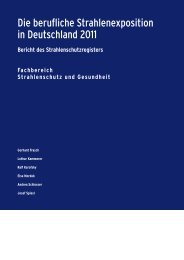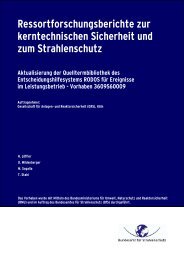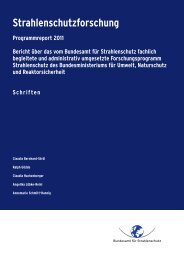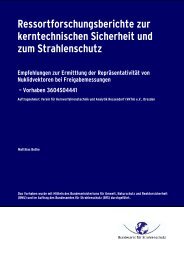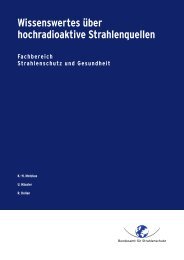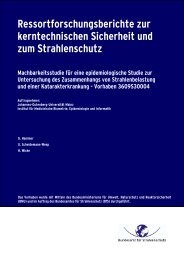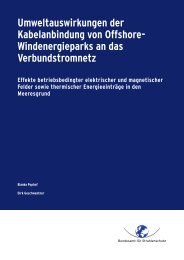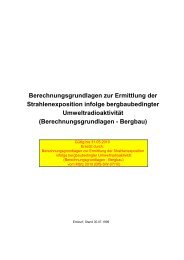Programmreport 2012 - DORIS - Bundesamt für Strahlenschutz
Programmreport 2012 - DORIS - Bundesamt für Strahlenschutz
Programmreport 2012 - DORIS - Bundesamt für Strahlenschutz
Erfolgreiche ePaper selbst erstellen
Machen Sie aus Ihren PDF Publikationen ein blätterbares Flipbook mit unserer einzigartigen Google optimierten e-Paper Software.
Incidents can happen, due to human or technical error, at any place where people work with radioactive substances<br />
or ionising radiation. This may cause radioactive substances to be released or people to be exposed<br />
to radiation. Determination and optimisation of precautionary measures against accidents and incidents is<br />
therefore one of BfS’ permanent tasks. Emergency management is an area that continually needs to be improved<br />
and the effectiveness of safety measures culminating in medical protective measures in the case of<br />
an overexposure needs to be optimised on an on-going basis.<br />
Apart from that, a number of projects deals with issues of general importance for radiation protection.<br />
Over the last few decades, changes in leisure activities and new fashion trends have led to ever increasing<br />
numbers of the population staying longer in the sun and using artificially made UV radiation in solariums. This<br />
trend necessitates new concepts and research measures in the field of protection from UV radiation.<br />
On top of this, man’s environment is increasingly influenced by the presence and the use of electrical devices<br />
as well as by the acceleration in the development of electronic media and wireless communication. The ongoing<br />
expansion in this trend requires that new tasks in the field of protection from the effects of non-ionising<br />
radiation to be performed.<br />
Apart from the existing well-founded scientific findings on health effects, there are hints for potential further<br />
biological effects at lower field intensities which have not yet been fully apprehended by scientists. For this<br />
reason, the German Mobile Telecommunication Research Programme (DMF) continued its research by<br />
systematically studying the effects of different uses of non-ionising radiation on man. The main emphasis of<br />
these research projects was in the fields of biology, epidemiology, dosimetry and risk communication. It was<br />
funded in equal shares by BMU and the German mobile phone network operators. In order to exclude possible<br />
conflicts of interest, the projects were assigned and scientifically overseen solely by BfS. The Research Programme<br />
was initiated by BfS and ended in 2008. Individual follow-up projects, assigned and scientifically overseen<br />
by BfS, are now being funded within the scope of the so-called DMF II.<br />
Summary of results from recent research projects<br />
In the following the results of selected research projects concluded in <strong>2012</strong> will be reported:<br />
SUBJECT AREA 01 - NATURAL RADIATION EXPOSURE<br />
For staff employed by German aircraft companies the effective dose due to cosmic radiation during the flight<br />
has to be determined. This is carried out by computer programs with input of air route, flight level, duration<br />
and date. A significant parameter for calculating is the solar activity. The project “Verification of dose rate<br />
in aircraft taking into account the solar cycle, the dislocation of magnetic poles and solar particle<br />
events in order to quality control for radiation dose calculation of air crews (3608S10003)“ checked<br />
whether the accredited programs calculate the dose within the regulated range. For that purpose three systems<br />
for dose measurements were assembled within planes of type Airbus A340 used by the Deutsche Lufthansa<br />
AG. The dose during 18 000 hours is measured at flight levels between 9 km and 12.5 km. Additionally<br />
the influence of solar flares should be determined, but during the operational hours of the project no significant<br />
dose relevant solar flare was registered.<br />
Aim of the project “Analysis of epigenetic effects (microRNAs) in former workers of the SAG/SDAG<br />
Wismut (3610S10001)“ was the development and establishment of an oligonucleotide microarray for expression<br />
analysis of microRNAs (miRNAs) in whole blood of former uranium miners. To identify possible biomarkers<br />
of radiation exposure, samples of high- and low-exposed miners were screened with microarrays that<br />
carried 703 human miRNA probes. To that end, 60 RNA samples of the project “Creation of a biological sample<br />
and data collection of occupationally radiation-exposed workers (German Uranium Miners Biobank) – a<br />
pilot study” (3607S04532) were analyzed and potential biomarkers verified by quantitative real-time PCR<br />
(qRT-PCR).<br />
During the initial screening, miRNA-548d-5p, showing a significantly altered expression between low- and<br />
high-exposed miners, was identified as a possible biomarker candidate. Verification by qRT-PCR confirmed<br />
the difference in expression; however, the result was not statistically significant.<br />
To study the leukemia mortality risk among uranium miners of the Wismut-cohort additional information on<br />
medical x-ray exposition was gathered from the archives of the former Wismut health services. For the project<br />
“Collection of the medical radiation exposure for a nested case control study on leukaemia in<br />
XX



